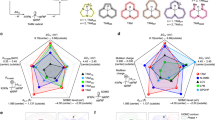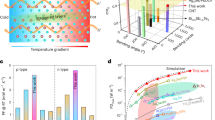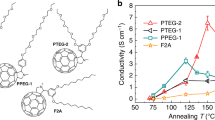Abstract
Organic semiconductors are attracting increasing interest as flexible thermoelectric materials owing to material abundance, easy processing and low thermal conductivity. Although progress in p-type polymers and composites has been reported, their n-type counterpart has fallen behind owing to difficulties in n-type doping of organic semiconductors. Here, we present an approach to synthesize n-type flexible thermoelectric materials through a facile electrochemical intercalation method, fabricating a hybrid superlattice of alternating inorganic TiS2 monolayers and organic cations. Electrons were externally injected into the inorganic layers and then stabilized by organic cations, providing n-type carriers for current and energy transport. An electrical conductivity of 790 S cm−1 and a power factor of 0.45 mW m−1 K−2 were obtained for a hybrid superlattice of TiS2/[(hexylammonium)x(H2O)y(DMSO)z], with an in-plane lattice thermal conductivity of 0.12 ± 0.03 W m−1 K−1, which is two orders of magnitude smaller than the thermal conductivities of the single-layer and bulk TiS2. High power factor and low thermal conductivity contributed to a thermoelectric figure of merit, ZT, of 0.28 at 373 K, which might find application in wearable electronics.
This is a preview of subscription content, access via your institution
Access options
Subscribe to this journal
Receive 12 print issues and online access
$259.00 per year
only $21.58 per issue
Buy this article
- Purchase on Springer Link
- Instant access to full article PDF
Prices may be subject to local taxes which are calculated during checkout




Similar content being viewed by others
References
Dimitrakopoulos, C. D. & Malenfant, P. R. L. Organic thin film transistors for large area electronics. Adv. Mater. 14, 99–117 (2002).
Janata, J. & Josowicz, M. Conducting polymers in electronic chemical sensors. Nature Mater. 2, 19–24 (2003).
Ouyang, J. Y., Chu, C. W., Szmanda, C. R., Ma, L. P. & Yang, Y. Programmable polymer thin film and non-volatile memory device. Nature Mater. 3, 918–922 (2004).
Burroughes, J. H. et al. Light-emitting-diodes based on conjugated polymers. Nature 347, 539–541 (1990).
Sariciftci, N. S., Smilowitz, L., Heeger, A. J. & Wudl, F. Photoinduced electron-transfer from conducting polymer to buckminsterfullerene. Science 258, 1474–1476 (1992).
Bubnova, O. et al. Optimization of the thermoelectric figure of merit in the conducting polymer poly(3,4-ethylenedioxythiophene). Nature Mater. 10, 429–433 (2011).
Kim, G. H., Shao, L., Zhang, K. & Pipe, K. P. Engineered doping of organic semiconductors for enhanced thermoelectric efficiency. Nature Mater. 12, 719–723 (2013).
Lu, Z. Y. et al. Fabrication of flexible thermoelectric thin film devices by inkjet printing. Small 10, 3551–3554 (2014).
Yadav, A., Pipe, K. P. & Shtein, M. Fiber-based flexible thermoelectric power generator. J. Power Sources 175, 909–913 (2008).
Barry, J. J., Hughes, H. P., Klipstein, P. C. & Friend, R. H. Stoichiometry effects in angle-resolved photoemission and transport studies of Ti1+xS2 . J. Phys. 16, 393–402 (1983).
Schollho, R. & Weiss, A. Cation-exchange reactions and layer solvate complexes of ternary phases MxMoS2 . J. Less-Common Met. 36, 229–236 (1974).
Li, Y. D. D., Li, X. L. L., He, R. R. R., Zhu, J. & Deng, Z. X. X. Artificial lamellar mesostructures to WS2 nanotubes. J. Am. Chem. Soc. 124, 1411–1416 (2002).
Ferrari, A. M., Szieberth, D., Zicovich-Wilson, C. M. & Demichelis, R. Anatase(001) 3 ML nanotubes, the first TiO2 nanotube with negative strain energies: A DFT prediction. J. Phys. Chem. Lett. 1, 2854–2857 (2010).
Tibbetts, K., Doe, R. & Ceder, G. Polygonal model for layered inorganic nanotubes. Phys. Rev. B 80, 014102 (2009).
Kukkonen, C. A. et al. Transport and optical-properties of Ti1+xS2 . Phys. Rev. B 24, 1691–1709 (1981).
Fang, C. M., deGroot, R. A. & Haas, C. Bulk and surface electronic structure of 1T-TiS2 and 1T-TiSe2 . Phys. Rev. B 56, 4455–4463 (1997).
Schollho, R. & Meyer, H. Cathodic reduction of layered transition-metal chalcogenides. Mater. Res. Bull. 9, 1237–1246 (1974).
Jena, D. & Konar, A. Enhancement of carrier mobility in semiconductor nanostructures by dielectric engineering. Phys. Rev. Lett. 98, 136805 (2007).
Sun, Y. M. et al. Organic thermoelectric materials and devices based on p- and n-type poly(metal 1,1,2,2-ethenetetrathiolate)s. Adv. Mater. 24, 932–937 (2012).
Tynell, T., Terasaki, I., Yamauchi, H. & Karppinen, M. Thermoelectric characteristics of (Zn, Al)O/hydroquinone superlattices. J. Mater. Chem. A 1, 13619–13624 (2013).
Zawilski, B. M., Littleton, R. T. & Tritt, T. M. Description of the parallel thermal conductance technique for the measurement of the thermal conductivity of small diameter samples. Rev. Sci. Instrum. 72, 1770–1774 (2001).
Imai, H., Shimakawa, Y. & Kubo, Y. Large thermoelectric power factor in TiS2 crystal with nearly stoichiometric composition. Phys. Rev. B 64, 241104 (2001).
Losego, M. D., Grady, M. E., Sottos, N. R., Cahill, D. G. & Braun, P. V. Effects of chemical bonding on heat transport across interfaces. Nature Mater. 11, 502–506 (2012).
Ong, W. L., Rupich, S. M., Talapin, D. V., McGaughey, A. J. H. & Malen, J. A. Surface chemistry mediates thermal transport in three-dimensional nanocrystal arrays. Nature Mater. 12, 410–415 (2013).
Losego, M. D., Blitz, I. P., Vaia, R. A., Cahill, D. G. & Braunt, P. V. Ultralow thermal conductivity in organoclay nanolaminates synthesized via simple self-assembly. Nano Lett. 13, 2215–2219 (2013).
Liu, J. et al. Ultralow thermal conductivity of atomic/molecular layer-deposited hybrid inorganic/organic zincone thin films. Nano Lett. 13, 5594–5599 (2013).
Thomas, J. A., Turney, J. E., Iutzi, R. M., Amon, C. H. & McGaughey, A. J. Predicting phonon dispersion relations and lifetimes from the spectral energy density. Phys. Rev. B 81, 081411 (2010).
Harshman, D. R. & Mills, A. P. Concerning the nature of high-T C superconductivity—survey of experimental properties and implications for interlayer coupling. Phys. Rev. B 45, 10684–10712 (1992).
Acknowledgements
The authors thank R. Sasai for polarized FTIR measurements. C.W. acknowledges financial support from a Murata Science Foundation Research Grant, a Thermal and Electrical Energy Technology Foundation Research Grant, Takahashi Industrial and Economic Research Foundation and JSPS KAKENHI Grant Number 26820295. K.Koumoto acknowledges financial support from JSPS KAKENHI Grant Number 25289226 and TherMAT. G.J.S. acknowledges support from AFOSR-MURI and DOE-EFRC (S3TEC) award number DE-SC0001299. X.G. and R.Y. acknowledge the partial support for this work from the NSF CAREER award (0846561) and AFOSR (FA9550-11-1-0109). The simulation work used the Janus supercomputer, supported by NSF (0821794).
Author information
Authors and Affiliations
Contributions
C.W. and K.Koumoto initiated the concepts. C.W. designed the experiments. C.W., F.D., T.I., Y.W., H.S., M.K., K.Koga and K.Y. conducted the experiments. X.G. and R.Y. performed the molecular dynamics simulations. C.W., X.G., G.J.S., R.Y. and K.Koumoto analysed the data and wrote the manuscript. All of the authors contributed to manuscript preparation.
Corresponding authors
Ethics declarations
Competing interests
The authors declare no competing financial interests.
Supplementary information
Supplementary Information
Supplementary Information (PDF 2664 kb)
Supplementary Information
Supplementary Movie 1 (MPG 3994 kb)
Rights and permissions
About this article
Cite this article
Wan, C., Gu, X., Dang, F. et al. Flexible n-type thermoelectric materials by organic intercalation of layered transition metal dichalcogenide TiS2. Nature Mater 14, 622–627 (2015). https://doi.org/10.1038/nmat4251
Received:
Accepted:
Published:
Issue Date:
DOI: https://doi.org/10.1038/nmat4251
This article is cited by
-
Controllable van der Waals gaps by water adsorption
Nature Nanotechnology (2024)
-
A chemical-dedoping strategy to tailor electron density in molecular-intercalated bulk monolayer MoS2
Nature Synthesis (2023)
-
Regulating the Electrical and Mechanical Properties of TaS2 Films via van der Waals and Electrostatic Interaction for High Performance Electromagnetic Interference Shielding
Nano-Micro Letters (2023)
-
Organic/inorganic hybrids for intelligent sensing and wearable clean energy applications
Advanced Composites and Hybrid Materials (2023)
-
Recent advances on liquid intercalation and exfoliation of transition metal dichalcogenides: From fundamentals to applications
Nano Research (2023)



